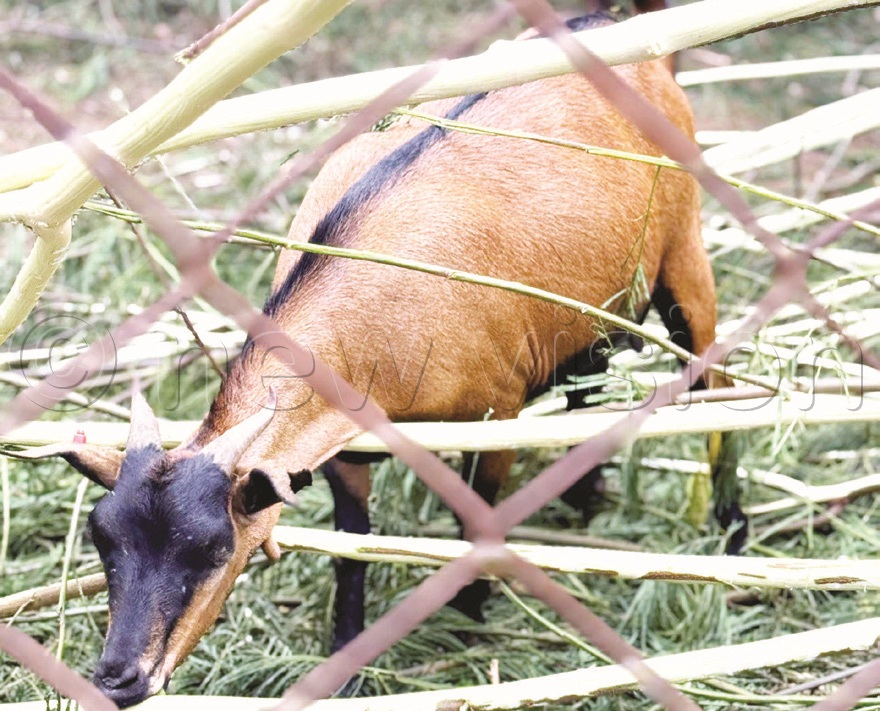Kasolwe brown goat heads the pack in meat, milk, livelihoods
Dr Gordon Ssengoye, NAGRC’s technical manager of production, calls the Kasolwe goat a “game-changer” for Uganda’s livestock industry.
The Kasolwe brown goat was developed by scientists at the National Animal Genetic Resources Centre and Data Bank at Kasolwe Stock Farm in Kamuli distric.
________________
In a move to revolutionise goat farming and boost rural incomes, the Government has introduced a new indigenous breed; the Kasolwe brown goat.
Developed by scientists at the National Animal Genetic Resources Centre and Data Bank (NAGRC&DB), this hardy, fast-growing and disease-resistant breed promises to transform smallholder farming across Uganda and other parts of Sub-Saharan Africa.
The 2024 livestock census puts the number of goats in Uganda at over 17 million, with the sector holding immense commercial potential, if the right breeds are used.
The Kasolwe brown goat
The majority of Uganda’s goat herd are indigenous breeds, whose growth is limited. Consequently, farmers have been struggling to meet the growing demand for goat meat and milk.
Many resorted to importing exotic breeds from South Africa, the UK and Switzerland; often at exorbitant costs.
“Crossbreeds require intensive management that smallholder farmers cannot afford,” Dr Benda Katali, the head of goat breeding at the National Genetics Research Centre, says.
“Even large-scale farmers find the costs erode their profits.”

The Kasolwe brown goat has a black mane running from its face to tail.
Studies by NAGRC&DB revealed that the economic benefits of crossbreeding were not significantly better than straight breeding among indigenous goats.
To change the landscape, NAGRC&DB developed the Kasolwe brown goat breed at its Kasolwe Stock Farm in Kamuli district, eastern Uganda. Over 10 years, researchers at NAGRC&DB have been working with private breeders and farmers in Kamuli and Buyende districts to create a foundation stock of over 500 goats.
“This breed is a breakthrough,” Katali says.
“It multiplies quickly, grows fast and is resistant to common diseases like haemonchosis and heart water,” he says.
The goats have an average of two kids, twice a year. They also gain weight faster than local breeds.
Dr Gordon Ssengoye, NAGRC’s technical manager of production, calls the Kasolwe goat a “game-changer” for Uganda’s livestock industry.
With proper support, Uganda could become a net exporter of goat genetics across Sub-Saharan Africa.
Scaling up distribution
Daniel Epinyu, the manager of Kasolwe Stock Farm, said the next step is mass multiplication of the breed. This will be done through the Kasolwe Goat Breed Society, a partnership between NAGRC&DB and Kasombereza Farm Solutions.
The goats can be accessed through NAGRC&DB farms and soon, across the country.
“Our goal is to make this breed accessible to farmers across Uganda,” Epinyu says.
“It will drive enterprise development, food security and rural transformation,” he added.
Target group
Because goat keeping is a low-cost investment that can be taken up by women and youths, Epinyu says while they carried out the research, they kept an eye on the target groups.
“Many women and youths invest their earnings in goat keeping, but get frustrated because of the poor growth rate of the goats. This Kasolwe breed is set to change that,” he says.
Grace Bwogi, renown goat farmer and trainer, agrees that goat keeping is a potential income earner for women and youths because of its low investment requirements.
She has also been key in improving the local breed through importing high value goats from South Africa.
“You can have five goats at just about sh1m and in just one year, the herd could be 15 goats. So, if an improved breed that can help you get money quickly is availed at reasonable investment, that is good,” Bwogi says.
Genetic research, conservation
In partnership with Makerere University and the Roslin Institute (University of Edinburgh), NAGRC&DB is conducting advanced genetic studies to identify traits linked to the breed’s environmental tolerance and immunity. These traits will be conserved in national and regional gene banks to prevent loss through uncontrolled crossbreeding.
“We are safeguarding Uganda’s genetic heritage,” Katali says.
“The Kasolwe goat is just the beginning,” he said.
Key traits of kasolwe brown goat:
Shiny dark brown coat (resistant to parasites)
- It has black mane from face to tail
- Sturdy limbs for rough terrain
- Large udders (support twins/triplets without supplementation)
- Features straight horns in females and young males; curved in adult males
- Features wattles on female necks
- Height: 65–90cm (females), 75–110cm (males)
- Weight: up to 65kg (females), 75kg (males) compared to Mubende’s 25- 35kg
- Daily weight gain: Up to 127g compared to 75.5grams for Mubende breed
- Weaning age: Three months compared to five for the local breeds
- Weaning weight: 12–15kg Comparative studies show the Kasolwe goat outperforms breeds like the Savanah, Boer, Mubende, Kigezi and Kalahari in twinning ability, disease resistance and adaptability to Uganda’s diverse agro-ecological zones.
Farmers speak out
James Tefula, a farmer in Kamuli
Compared to other indigenous breeds, these goats grow faster and need less feed as they have a high feed conversion rates.
“I’ve never seen my herd grow this quickly,” he says.
Charles Mutiibwa, farmer
They are resistant to local diseases, which has cut my veterinary costs significantly.